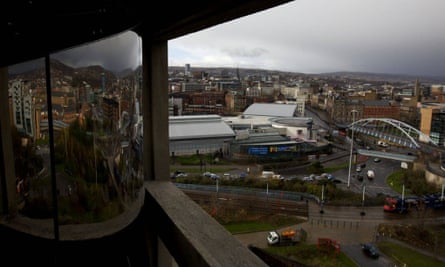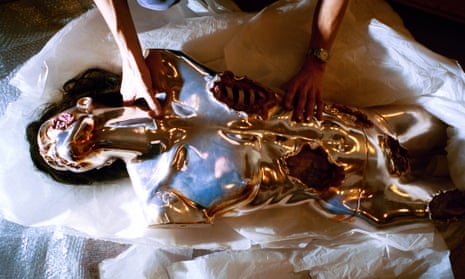It seems unlikely that Jake and Dinos Chapman would have thought Cyber Iconic Man – their sculpture depicting a naked figure upside down, its blood splashing into a bucket – might ever be exhibited in an ecclesiastical setting.
Yet, come September, visitors and parishioners visiting Sheffield Cathedral for a moment of quiet reflection will find themselves in the company not just of stained glass windows and gilded biblical panels, but this gory piece of contemporary art – dripping blood and all.
It is part of a city-wide project across Sheffield to bring artworks owned by some of Europe’s most prestigious collectors into venues across the city, making them freely accessible to the public.
As well as the Chapman brothers’ piece, Sheffield Cathedral will exhibit pieces by Sarah Lucas and Maurizio Cattelan, all drawn from the collection of Patrizia Sandretto Re Rebaudengo, while the Graves Gallery will display rarely seen works by Marcel Duchamp, owned by German collector Egidio Marzona.
The city’s Millennium Gallery, Sheffield Hallam University and Site Gallery will also host works from the collectors involved in the project, titled Going Public, which aims to convince the city’s population of the value of contemporary art and to display pieces that would rarely be seen outside London, if at all.
Peter Bradley, dean of Sheffield Cathedral, said the congregation were “very up for it”. Having selected the work from the collection himself, he admitted he had rejected the first offerings because they were “too tame”.
“This is a new beginning for contemporary art in Sheffield that the whole city has engaged with,” said Bradley, adding that the Cyber Iconic Man will be specially placed in the cathedral’s gilded Chapel of the Holy Spirit for the five-month period.
“It is a beautiful space, with very nice light and I think the Chapman piece in the middle will be quite arresting,” he added. “ Of course there are many images of violence in the cathedral already, crucifixes and so forth, that we are desensitised to, and we are hoping the piece will lead to a debate around violence and religion and martyrdom.”
The project also aims to have wider implications, both nationally and internationally, opening up discussion about the involvement of private collectors and investors in the future of public art.
In a world of crippling cuts to state-funded museums and galleries – which have hit areas such as Sheffield particularly hard – the only way public art institutions will survive is if they learn to work long-term with the private sector, argued both the project organisers, Mark Doyle and Sebastian Montabonel, and the CEO of Museums Sheffield, Kim Streets.
Streets said: “This is great opportunity explore the notion of philanthropy in the public art sector in the 21st century. This is potentially a new model for institutions across the nation.”

“Sheffield Museums are majority public funded and of course there is a careful balance,” she added. “But I imagine a future where the public funding disappears, perhaps in 10 years time. The idea here is that philanthropists can play a role in developing public art galleries in the future and I think that’s very important for regional institutions in particular. We all need to develop a vision of what public arts will be like in 20 or 30 years time.”
To recognise this was not to admit defeat, or accept the arts industry selling out to business – Streets pointed to the art world’s historical reliance on philanthropists and collectors in the early 20th century.
Montabonel said that while London arts institutions already had the attention of private collectors and businesses, this was about drawing their eyes - and artworks - to the regions beyond.
“Art cannot only be in London,” he said. “Regional museums are just as important and they need to be prepared or they will not survive.”
They key was to act now while institutions still had the power and ability to set ground rules for private investment that would “preserve integrity and quality,” said Montabonel. As part of the project, a summit will also be held in Sheffield to discuss the impact of private philanthropy on the arts in the 21st century, and a paper of the findings will be distributed to institutions across Europe.
To ensure that private and personal interests did not impinge on the project, Montabonel and Doyle specifically invited only four collectors already involved in philanthropic and publicly minded initiatives to take part in the Sheffield project.
London-based collector Nicolas Cattelain, who regularly lends his collection of post-war art to galleries around Europe, is one of those involved. He understood the reticence to involve private figures in sanctified public arts institutions, he said.
“The elephant in the room here is when private collectors and investors can try and promote certain things, as we all know already happens in museums around the world.”
But with the fall in arts funding, and the rising prices of contemporary art, Cattelain argued that collectors and private partnerships had a vital role to play. “The important thing is that institutions have the vision to maintain their integrity, whilst also securing their future.”

Comments (…)
Sign in or create your Guardian account to join the discussion